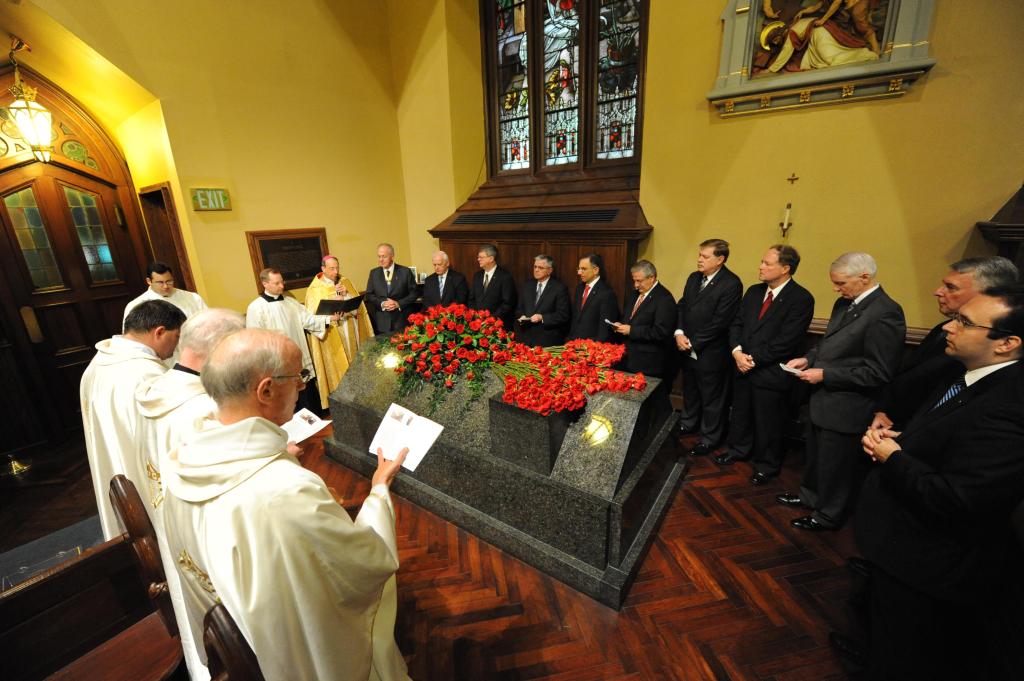New Haven is the world headquarters of the Knights of Columbus and is where Blessed Michael McGivney first established the Order in 1882. New Haven is an easy day trip from Boston or New York City; it is about a two hour drive from each of those cities.
Arriving in the coastal town of New Haven on Long Island Sound, visitors step far back into history. In fact, when it was established in 1638, New Haven was the first planned city in the Thirteen Colonies. Its relative importance has waned over time as other cities along the eastern seaboard rose in wealth and prominence, but there are two major draws that continue to keep this quintessential New England town on the map. The first is the world renowned Yale University, one of the prestigious Ivy League universities in the country. The second are the sites linked to Blessed Michael McGivney and the Knights of Columbus; the lay fraternal organization that has revolutionized and reinvigorated the lives of Catholic men and families the world over.

St. Mary’s Church, the city’s first Catholic Church, is the final resting place of Blessed Michael McGivney, the founder of the Knights of Columbus. It is was here, in 1882, that he formed the Knights of Columbus and established the first council of this now global order.
When St. Mary’s was established in 1879, it drew considerable scorn from the city’s Protestant elite. The New York Times even ran a story titled, “How an Aristocratic Avenue was blemished by a Roman Church Edifice.” It was against this context, and in an age when secular secret societies were prevalent, that Father McGivney saw the need to create a fraternal male society to look after Catholic men and their families to provide both male fellowship in faith and financial assistance to Catholic families suffering illness or death.
By June 1889, the Order had expanded to over five thousand members and fifty-one councils. Today, there are over 1.8 million Knights worldwide and over 14,000 councils and over $86 billion of life insurance in force. The Order has also spread internationally, to Canada, Mexico, the Philippines, Poland, and Ukraine. Father McGivney died at the age of thirty eight from tuberculosis in 1890.

Pilgrims visiting St. Mary’s can pray at the tomb of Blessed McGivney, located near the entrance to the church. They can also tour the garden between the church and the priory, with an outdoor display on the life of Blessed Michael McGivney.

From St. Mary’s Church, it is a short drive to the headquarters of the Knights of Columbus to visit the Blessed Michael McGivney Pilgrimage Center It features a number of permanent exhibits, including a gallery of the popes, a gallery on the life of Fr. McGivney and a 170 foot long wall of history detailing the evolution of the Knights of Columbus. Treasures housed within the Center include a 400 year old cross from St. Peter’s Basilica in Rome (a gift from St. John Paul II) and a reliquary room displaying relics of Blessed McGivney.
The story of the Knights of Columbus is nothing short of incredible. From these humble beginnings in New Haven, it spread like wildfire. It is hard to drive through any small town in America today without coming across the Knights’ emblem emblazoned next to those of other service organizations like the Lions’ Club or the Rotarians, or going to the weekly fish fry or bingo at the local KoC hall. There is no other lay Catholic organization that has so successfully bred and passed down, from generation to generation, the core virtues of charity, patriotism, unity and fraternity, materialized in the corporal works of mercy in local communities and on a larger national and global scale, such as such as their unyielding support for pro-life causes, persecuted Christians in the Middle East, and support for the church in the Holy Land.
Other New Haven highlights
After visiting the Pilgrimage Center, be sure to spend some time exploring this quaint coastal city. The campus of Yale University is the primary attraction. In addition to exploring its splendid architecture, the campus is home to several renowned museums, including the Yale Peabody Museum of Natural History, the Yale University Art Gallery and the Yale Center for British Art (the largest collection of British Art outside of the British isles). Be sure to also visit the Catholic chapel on campus, St. Thomas More Chapel and the adjoining Golden Center. Also check their website before visiting, as the Center hosts many fascinating lectures and events throughout the year.
Last, but not least, New Haven lays claim to being the town where the hamburger was invented at the turn of the last century. If this caught your attention, do not leave turn without stopping at Louis’ Lunch. It was at this rustic restaurant, in operation since 1895, that the hamburger was invented.
Leave a comment